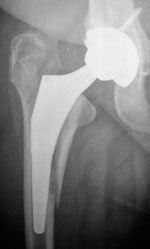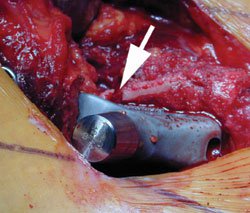Technique, patient and implant selection key to avoiding fracture during THA
 Craig J. Della Valle |
ORLANDO, Fla. — At the Current Concepts in Joint Replacement 2011 Winter Meeting, Craig J. Della Valle, MD, provided tips on the prevention of intraoperative fractures during total hip arthroplasty.
“Prevention is key,” Della Valle said, noting that appropriate exposure is crucial.
In a study of more than 5,000 hip replacements performed by 11 surgeons during a 10-year period, Della Valle and colleagues found that risk factors for fracture include elderly patients, female patients and type of stem used. He noted that flat-wedge taper designs have a high risk for early postoperative and intraoperative fracture. Developmental dysplasia of the hip was also substantial risk factor.
The decision to use a cemented or uncemented implant is also key.
“It is important to recognize that, although we like to use cementless stems for a variety of reasons, there are some patients where a cemented stem is going to be the right answer,” Della Valle said. “[In] a frail, elderly, osteoporotic female, a cemented stem may be the safest choice.”
|
Images: Della Valle C |
In cases of stiff hips or those with prior hardware in the proximal femur, Della Valle recommended caution to prevent potential problems from torquing the femur.
“Although it is our desire to get in there, open up the incision and start removing that hardware, dislocate the hip first to avoid that bad situation where you get a spiral fracture of the femur,” he said.
Minimally invasive THA
Inadequate visualization is among the most common causes of fracture.
“While interest in less invasive approaches has waned, however to a certain extent we are all operating through smaller incisions than we used to. The literature shows pretty clearly that the use of so-called “MIS” approaches is a risk factor for intraoperative and early postoperative fractures, particularly when a surgeon is first learning these techniques” Della Valle, an Orthopedics Today Editorial Board member, said. “No matter what exposure you are using, it is important to make sure you can adequately visualize the proximal femur, particularly if you are trying to learn a new exposure.”
Della Valle also recommended that surgeons not force the broach during implantation, noting that it should advance with every blow of the mallet; “If the broach stops moving and the surgeon keeps hitting it, that force has to go somewhere and a fracture is oftentimes the result.”
When inserting the final stem, if the implant goes deeper than the last broach, the surgeon should be suspicious and remove the stem to look for a fracture. Della Valle added, that “if there is any question in your mind of whether a fracture has occurred, I would strongly recommend getting an intraoperative X-ray.”
Revision procedures
When using full porous coated stems during revision cases, Della Valle said surgeons should be wary of the stem size printed on the box.
“There is some inherent variability in the diameter of a fully porous coated stem, so you want to check with a hole gauge to ensure that you know how big the stem really is,” he said noting that this process will prevent under-reaming by more than is desired by the surgeon.
|
|
“Sometimes we will see stems that match the labeled sized exactly, more often than not they are 0.5 mm larger than labeled, but occasionally we will see a stem that is a full 1 mm larger than the labeled size,” Della Valle said.
For extended trochanteric osteotomies and periprosthetic fractures, it is important to place a prophylactic cerclage wire just distal to the end of the osteotomy/fracture, to prevent inadvertent distal propagation during femoral canal preparation or final implant insertion.
Treatment
If a fracture is identified or suspected intraoperatively, he said that the first step is to remove the stem (or broach) and carefully inspect the fracture. If a fracture is confirmed, the options are either to place a cerclage wire around the proximal femur and re-insert the stem or convert to a stem that gains primary fixation distally. While the use of a cerclage wire has “good literature to support that it works in most cases, we have certainly seen cases where this approach has failed and I prefer in most cases to convert to a distally fixed fully porous coated stem,” Della Valle said. – by Jeff Craven
Reference:
- Della Valle CJ. Intraoperative fractures during THA: See it before it sees us. Paper #19. Presented at the Current Concepts in Joint Replacement 2011 Winter Meeting. Dec. 7-10. Orlando, Fla.

- Craig J. Della Valle, MD, can be reached at the Department of Orthopaedic Surgery, Rush University Medical Center, 1725 West Harrison, Suite 1063, Chicago, IL 60612; 312-432-2350; email: craigdv@yahoo.com.
- Disclosure: Della Valle received research support from Smith & Nephew and Stryker, is on the scientific advisory board for CD Diagnostics and is a consultant to Biomet, Convatec and Smith & Nephew.
The authors report on the risk of fracturing the proximal femur when implanting uncemented stems, and the need to identify and properly treat the fracture should it occurs. If performed by orthopedic surgeons experienced in hip arthroplasty, uncemented fixation can result in optimal implant stability and good clinical outcomes. On the contrary, if performed by inexperienced surgeons, there is a greater risk of a fracture occurring. This is also the case in patients with congenital hip dysplasia, those with a distorted proximal femoral anatomy, female patients and in cases where a minimally invasive approach is used, as this does not always allow for good visualization and exposure of the hip.
Therefore, the take-home message is that specific experience in hip surgery is needed in order to successfully perform uncemented total hip arthroplasty, particularly if a fracture occurs, as prompt treatment such as additional fixation or the use of a longer femoral component should be implemented.
— Antonio Moroni, MD
Professor, School of
Sports Science
Bologna University, Italy
Disclosure: Moroni has
no relevant financial disclosures.







